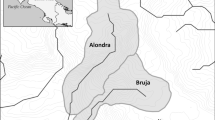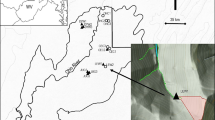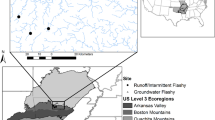Abstract
Highly seasonal rivers can experience extended low flow, and often dry, periods. Macroinvertebrate and flow data were used to explore hypotheses on the effects of antecedent hydrology and the low-flow, dry-season period on macroinvertebrate assemblages in northern Australia. Composition differed between early and late dry seasons. Taxa were more sensitive to water quality and more rheophilous in the early dry season when their habitats were lotic than when habitats later became lentic. As flow magnitudes in the antecedent dry season and on the sampling day increased, the habitats became more oxygenated and, in turn, macroinvertebrate richness increased. Higher wet-season flow magnitudes, flow variability and rates of fall were correlated with lower richness in the following dry season. Alteration of the flow-disturbance regime that increases the likelihood of flow cessation in macroinvertebrate habitats, or extends the duration of the dry season beyond that previously experienced in these highly seasonal systems, may alter the resistance and resilience of assemblages such that the seasonal decline and recovery of biodiversity may no longer be so reliable. Given the projected increase in low-flow incidence in many regions of the world, future research needs to examine the effects of reduced flow, flow cessation and stream drying as multiple, interacting stressors on stream biota.







Similar content being viewed by others
References
Anderson, M. J., 2001. A new method for nonparametric multivariate analysis of variance. Austral Ecology 26: 32–46.
Anderson, M. J., R. N. Gorley & K. R. Clarke, 2008. PERMANOVA+ for PRIMER: Guide to Software and Statistical Methods. PRIMER-E, Plymouth.
Arrington, D. A. & K. O. Winemiller, 2006. Habitat affinity, the seasonal flood pulse, and community assembly in the littoral zone of a Neotropical floodplain river. Journal of the North American Benthological Society 25: 126–141.
AWRC (Australian Water Resources Council), 1976. Review of Australia’s Water Resources 1975. Department of Natural Resources. Canberra, Australia.
Bogan, M. T. & D. A. Lytle, 2007. Seasonal flow variation allows ‘time-sharing’ by disparate aquatic insect communities in montane desert streams. Freshwater Biology 52: 290–304.
Bogan, M. T. & D. A. Lytle, 2012. Severe drought drives novel community trajectories in desert stream pools. Freshwater Biology 56: 2070–2081.
Bonada, N., M. Rieradevall & N. Prat, 2007. Macroinvertebrate community structure and biological traits related to flow permanence in a Mediterranean river network. Hydrobiologia 589: 91–106.
Boulton, A. J., 2003. Parallels and contrasts in the effects of drought on stream macroinvertebrate assemblages. Freshwater Biology 48: 1173–1185.
Boulton, A. J. & P. S. Lake, 1992. The ecology of two intermittent streams in Victoria, Australia. III. Temporal changes in faunal composition. Freshwater Biology 27: 123–138.
Boulton, A. J. & P. J. Suter, 1986. Ecology of temporary streams—an Australian perspective. In De Deckker, P. & W. D. Williams (eds), Limnology in Australia. Council for Scientific and Industrial Research. Junk, Melbourne: 486–496.
Boulton, A. J., C. G. Peterson, N. B. Grimm & S. G. Fisher, 1992. Stability of an aquatic macroinvertebrate community in a multiyear hydrologic disturbance regime. Ecology 73: 2192–2207.
Boulton, A. J., L. Boyero, A. P. Covich, M. Dobson, S. Lake & R. Pearson, 2008. Are tropical streams ecologically different from temperate streams? In Dudgeon, D. (ed.), Tropical Stream Ecology. Elsevier, London: 257–284.
Boyero, L., A. Ramírez, D. Dudgeon & R. G. Pearson, 2009. Are tropical streams really different? Journal of the North American Benthological Society 28: 397–403.
Brooks, A. J., B. C. Chessman & T. Haeusler, 2011. Macroinvertebrate traits distinguish unregulated rivers subject to water abstraction. Journal of the North American Benthological Society 30: 419–435.
Chessman, B. C., 2003. New sensitivity grades for Australian river macroinvertebrates. Marine & Freshwater Research 54: 95–103.
Chessman, B. C., 2009. Climatic changes and 13-year trends in stream macroinvertebrate assemblages in New South Wales, Australia. Global Change Biology 15: 2791–2802.
Chessman, B. C., M. J. Royal & M. Muschal, 2008. Does water abstraction from unregulated streams affect aquatic macrophyte assemblages? An evaluation based on comparisons with reference sites. Ecohydrology 1: 67–75.
Chessman, B. C., H. A. Jones, N. K. Searle, I. O. Growns & M. R. Pearson, 2010. Assessing effects of flow alteration on macroinvertebrate assemblages in Australian dryland rivers. Freshwater Biology 55: 1780–1800.
Cook, B., B. Pusey, J. Hughes & M. Kennard, 2010. Delineation of freshwater bioregions in northern Australia. In M. J. Kennard (ed.), Identifying High Conservation Value Aquatic Ecosystems in Northern Australia. Final Report for the Department of Environment, Water, Heritage and the Arts and the National Water Commission. Charles Darwin University, Darwin, Australia: 57–74.
Cotner, J. B., J. V. Montoya, D. L. Roelke & K. O. Winemiller, 2006. Seasonally variable riverine production in the Venezuelan llanos. Journal of the North American Benthological Society 25: 171–184.
Datry, T., 2012. Benthic and hyporheic invertebrate assemblages along a flow intermittence gradient: effects of duration of dry events. Freshwater Biology 57: 563–574.
Dewson, Z. S., A. B. W. James & R. G. Death, 2007. A review of the consequences of decreased flow for instream habitat and macroinvertebrates. Journal of the North American Benthological Society 26: 401–415.
Douglas, M. M., S. E. Bunn & P. M. Davies, 2005. River and wetland food webs in Australia’s wet–dry tropics: general principles and implications for management. Marine & Freshwater Research 56: 329–342.
Finn, M. A., A. J. Boulton & B. C. Chessman, 2009. Ecological responses to artificial drought in two Australian rivers with differing water extraction. Fundamental and Applied Limnology 175: 231–248.
Garcia, E., P. Dostine, C. Humphrey, M. Douglas, B. Pusey & B. Cook, 2011. Aquatic invertebrates. In Pusey, B. J. (ed.), Aquatic Biodiversity in Northern Australia: Patterns, Threats and Future. CDU Press, Darwin: 51–70.
Humphrey, C., J. Hanley & C. Camilleri, 2008. Report 6: aquatic invertebrates. In G. P. Lukacs & C. M. Finlayson (eds), A Compendium of Ecological Information on Australia’s Northern Tropical Rivers. Sub-project 1 of Australia’s Tropical Rivers—An Integrated Data Assessment and Analysis (DET18). A Report to Land & Water Australia. National Centre for Tropical Wetland Research, Townsville, Australia.
Jacobsen, D. & A. Encalada, 1998. The macroinvertebrate fauna of Ecuadorian highland streams in the wet and dry season. Archiv fur Hydrobiologie 142: 53–70.
Jowett, I. G., J. Richardson & M. L. Bonnett, 2005. Relationship between flow regime and fish abundances in a gravel-bed river, New Zealand. Journal of Fish Biology 66: 1419–1436.
Kay, W. R., M. J. Smith, A. M. Pinder, J. M. McRae, J. A. Davis & S. A. Halse, 1999. Patterns of distribution of macroinvertebrate families in rivers of north-western Australia. Freshwater Biology 41: 299–316.
Kennard, M. J., B. J. Pusey, J. D. Olden, S. J. Mackay, J. L. Stein & N. Marsh, 2010a. Classification of natural flow regimes in Australia to support environmental flow management. Freshwater Biology 55: 171–193.
Kennard, M., B. Pusey, J. Boyden, D. Burrows, C. Leigh, C. Perna, P. Bayliss & A. Georges, 2010b. Compilation of species distribution datasets for use as biodiversity surrogates. In M. J. Kennard (ed.), Identifying High Conservation Value Aquatic Ecosystems in Northern Australia. Final Report for the Department of Environment, Water, Heritage and the Arts and the National Water Commission. Charles Darwin University, Darwin, Australia: 48–56.
Lake, P. S., 2000. Disturbance, patchiness, and diversity in streams. Journal of the North American Benthological Society 19: 573–592.
Lake, P. S., 2003. Ecological effects of perturbation by drought in flowing waters. Freshwater Biology 48: 1161–1172.
Latrubesse, E. M., J. C. Stevaux & R. Sinha, 2005. Tropical rivers. Geomorphology 70: 187–206.
Ledger, M. E., F. K. Edwards, L. E. Brown, A. M. Milner & G. Woodward, 2011. Impact of simulated drought on ecosystem biomass production: an experimental test in stream mesocosms. Global Change Biology 17: 2288–2297.
Leigh, C., 2012. Macroinvertebrate Responses to Dry Season and Antecedent Flow in Highly Seasonal Streams and Rivers of the Wet–Dry Tropics, Northern Territory. National Water Commission, Canberra, Australia.
Leigh, C. & F. Sheldon, 2008. Hydrological changes and ecological impacts associated with water resource development in large floodplain rivers in the Australian tropics. River Research and Applications 24: 1251–1270.
Leigh, C. & F. Sheldon, 2009. Hydrological connectivity drives patterns of macroinvertebrate biodiversity in floodplain rivers of the Australian wet/dry tropics. Freshwater Biology 54: 549–571.
Leigh, C., M. A. Burford, F. Sheldon & S. E. Bunn, 2010. Dynamic stability in dry season food webs within tropical floodplain rivers. Marine & Freshwater Research 61: 357–368.
Leigh, C., B. Stewart-Koster, F. Sheldon & M. A. Burford, 2012. Understanding multiple ecological responses to anthropogenic disturbance: rivers and potential flow regime change. Ecological Applications 22: 250–263.
Leung, A. S. L. & D. Dudgeon, 2011. Scales of spatiotemporal variability in macroinvertebrate abundance and diversity in monsoonal streams: detecting environmental change. Freshwater Biology 56: 1193–1208.
Leung, A. S. L., A. O. Y. Li & D. Dudgeon, 2012. Scales of spatiotemporal variation in macroinvertebrate assemblage structure in monsoonal streams: the importance of season. Freshwater Biology 57: 218–231.
Lloyd, J. & S. Cook, 2001. Northern Territory AUSRIVAS: Australian River Assessment Scheme Sampling and Processing Manual. Natural Resources Division, Department of Lands, Planning and Environment, Northern Territory, Australia.
Lytle, D. A., J. D. Olden & L. E. McMullen, 2008. Drought escape behaviours of aquatic insects may be adaptations to highly variable flow regimes characteristic of desert rivers. The Southwestern Naturalist 53: 399–402.
Marchant, R., 1982. Seasonal variation in the macroinvertebrate fauna of billabongs along Magela Creek, Northern Territory. Australian Journal of Marine and Freshwater Research 33: 329–342.
Marchant, R., 1989. A subsampler for samples of benthic invertebrates. Bulletin of the Australian Society for Limnology 12: 49–52.
Marsh, N. A., M. J. Stewardson & M. J. Kennard, 2003. River Analysis Package. Cooperative Research Centre for Catchment Hydrology. Monash University, Melbourne.
Marsh, N., F. Sheldon & R. Rolls, 2012. Synthesis of case studies quantifying ecological responses to low flows. National Water Commission, Canberra, Australia [available on internet at http://archive.nwc.gov.au/library/waterlines/76]. Accessed 18 Oct 2012.
McCabe, D. J. & N. J. Gotelli, 2000. Effects of disturbance frequency, intensity, and area on assemblages of stream macroinvertebrates. Oecologia 124: 270–279.
McMahon, T. A. & B. L. Finlayson, 2003. Droughts and anti-droughts: the low flow hydrology of Australian rivers. Freshwater Biology 48: 1147–1160.
Miller, S. W., D. Wooster & J. Li, 2007. Resistance and resilience of macroinvertebrates to irrigation water withdrawals. Freshwater Biology 52: 2494–2510.
Milly, P. C. D., K. A. Dunne & A. V. Vecchia, 2005. Global pattern of trends in streamflow and water availability in a changing climate. Nature 438: 347–350.
Montoya, J. V., D. L. Roelke, K. O. Winemiller, J. B. Cotner & J. A. Snider, 2006. Hydrological seasonality and benthic algal biomass in a neotropical floodplain river. Journal of the North American Benthological Society 25: 157–170.
Nolte, U., M. J. de Oliveira & E. Stur, 1997. Seasonal, discharge-driven patterns of mayfly assemblages in an intermittent Neotropical stream. Freshwater Biology 37: 333–343.
Oksanen, J., F. G. Blanchet, R. Kindt, P. Legendre, P. R. Minchin, R. B. O’Hara, G. L. Simpson, P. Solymos, M. H. H. Stevens & H. Wagner, 2012. Vegan: Community Ecology Package. R package version 2.0-3 [available on internet at http://CRAN.R-project.org/package=vegan]. Accessed 18 Oct 2012.
Outridge, P., 1988. Seasonal and spatial variations in benthic macroinvertebrate communities of Magela Creek, Northern Territory. Australian Journal of Marine and Freshwater Research 39: 211–223.
Paltridge, R. M., P. L. Dostine, C. L. Humphrey & A. J. Boulton, 1997. Macroinvertebrate recolonization after re-wetting of a tropical seasonally-flowing stream (Magela Creek, Northern Territory, Australia). Marine & Freshwater Research 48: 633–645.
Perna, C. & R. G. Pearson, 2008. Temporal dynamics of fish assemblages in small seasonal streams in the Queensland tropics. Australian Journal of Zoology 56: 65–73.
Petheram, C., T. A. McMahon & M. C. Peel, 2008. Flow characteristics of rivers in northern Australia: implications for development. Journal of Hydrology 357: 93–111.
Pettit, N. E., P. Bayliss, P. M. Davies, S. K. Hamilton, D. M. Warfe, S. E. Bunn & M. M. Douglas, 2011. Seasonal contrasts in carbon resources and ecological processes on a tropical floodplain. Freshwater Biology 56: 1047–1064.
Poff, N. L., J. D. Allan, M. B. Bain, J. R. Karr, K. L. Prestegaard, B. D. Richter, R. E. Sparks & J. C. Stromberg, 1997. The natural flow regime: a paradigm for river conservation and restoration. BioScience 47: 769–784.
Ramírez, A., C. M. Pringle & M. Douglas, 2006. Temporal and spatial patterns in stream physicochemistry and insect assemblages in tropical lowland streams. Journal of the North American Benthological Society 25: 108–125.
Rayner, T. S., B. Pusey & R. G. Pearson, 2008. Seasonal flooding, instream habitat structure and fish assemblages in the Mulgrave River, north-east Queensland: towards a new conceptual framework for understanding fish-habitat dynamics in small tropical rivers. Marine & Freshwater Research 59: 97–116.
Rolls, R. J., C. Leigh & F. Sheldon, 2012. Mechanistic effects of low-flow hydrology on riverine ecosystems: ecological principles and consequences of alteration. Freshwater Science 31: 1163–1186.
Rose, P., L. Metzeling & S. Catzikiris, 2008. Can macroinvertebrate rapid bioassessment methods be used to assess river health during drought in south eastern Australian streams? Freshwater Biology 53: 2626–2638.
Schäfer, R. B., B. J. Kefford, L. Metzeling, M. Liess, S. Burgert, R. Marchant, V. Pettigrove, P. Goonan & D. Nugegoda, 2011. A trait database of stream invertebrates for the ecological risk assessment of single and combined effects of salinity and pesticides in South-East Australia. Science of the Total Environment 409: 2055–2063.
Sheldon, F. & C. S. Fellows, 2010. Water quality in two Australian dryland rivers: spatial and temporal variability and the role of flow. Marine & Freshwater Research 61: 864–874.
Stevenson, R. J. & S. Sabater, 2010. Understanding effects of global change on river ecosystems: science to support policy in a changing world. Hydrobiologia 657: 3–18.
Stubbington, R., P. J. Wood & A. J. Boulton, 2009. Low flow controls on benthic and hyporheic macroinvertebrate assemblages during supra-seasonal drought. Hydrological Processes 23: 2252–2263.
Townsend, S. A. & A. V. Padovan, 2005. The seasonal accrual and loss of benthic algae (Spirogyra) in the Daly River, an oligotrophic river in tropical Australia. Marine & Freshwater Research 56: 317–327.
Walters, A. W. & D. M. Post, 2011. How low can you go? Impacts of a low-flow disturbance on aquatic insect communities. Ecological Applications 21: 163–174.
Warfe, D. M., N. E. Pettit, P. M. Davies, B. J. Pusey, S. K. Hamilton, M. J. Kennard, S. A. Townsend, P. Bayliss, D. P. Ward, M. M. Douglas, M. A. Burford, M. Finn, S. E. Bunn & I. A. Halliday, 2011. The ‘wet–dry’ in the wet–dry tropics drives river ecosystem structure and processes in northern Australia. Freshwater Biology 56: 2169–2195.
Webster, I. T., N. Rea, A. V. Padovan, P. Dostine, S. A. Townsend & S. Cook, 2005. An analysis of primary production in the Daly River, a relatively unimpacted tropical river in northern Australia. Marine & Freshwater Research 56: 303–316.
Wood, P. J., A. J. Boulton, S. Little & R. Stubbington, 2010. Is the hyporheic zone a refugium for aquatic macroinvertebrates during severe low flow conditions? Fundamental and Applied Limnology 176: 377–390.
Zeug, S. C. & K. O. Winemiller, 2008. Relationships between hydrology, spatial heterogeneity, and fish recruitment dynamics in a temperate floodplain river. River Research and Applications 24: 90–102.
Acknowledgments
This study develops upon a report by CL to the National Water Commission, Australia, as part of the National Water Commission project, “Low Flow Ecological Response and Recovery”. The report (Leigh, 2012) was completed with the support of Charles Darwin University, as part of the Tropical Rivers and Coastal Knowledge (TRaCK) research hub. Peter Dostine and the Northern Territory Department of Natural Resources, Environment, The Arts and Sport (NRETAS) provided the daily flow and AUSRIVAS sample data. I thank Fran Sheldon, Rob Rolls, Nick Marsh and Simon Townsend for discussions on low flows and Northern Territory systems, Peter Dostine for valued discussions on the AUSRIVAS data and comments on drafts of this manuscript, and Belinda Gallardo and an anonymous reviewer for their comments on the manuscript.
Author information
Authors and Affiliations
Corresponding author
Additional information
Handling editor: David Dudgeon
Rights and permissions
About this article
Cite this article
Leigh, C. Dry-season changes in macroinvertebrate assemblages of highly seasonal rivers: responses to low flow, no flow and antecedent hydrology. Hydrobiologia 703, 95–112 (2013). https://doi.org/10.1007/s10750-012-1347-y
Received:
Revised:
Accepted:
Published:
Issue Date:
DOI: https://doi.org/10.1007/s10750-012-1347-y




